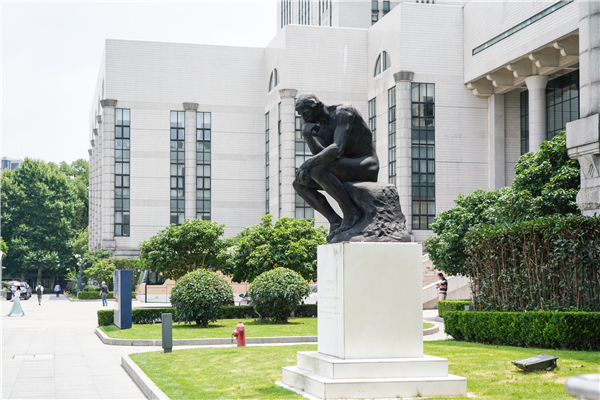
As one of China’s largest cities and its financial centre, Shanghai, with its openness, innovation and inclusiveness, plays an important role in the Chinese diplomatic cause.
Since the US table tennis team visited Shanghai in 1971 and former US President Nixon paid a visit to China issuing the Shanghai Communiqué in the Grand Hall of Jinjiang Hotel in 1972, Shanghai has witnessed the normalization and development of Sino-US relations. This culminated on January 1, 1979, when the two countries established a diplomatic relationship, starting a new chapter for both of them.
2019 now marks the 40th anniversary this historic event. On July 6, organized by Eastday and Shanghai People’s Association for Friendship with Foreign Countries (SPAFFC), a visiting journey themed “Trans-Pacific Exchange and Cooperation—Shanghai Commemorates 40th Anniversary of China-US Diplomatic Relations” was undertaken, inviting guests to trace the milestones of bilateral ties.
Guided by the Shanghai Library’s former Party Secretary Wang Heming and its former deputy director Miao Qihao, the guests visited the library to learn more about the stories behind this cultural landmark of Shanghai.
Founded in 1952 and located on Middle Huaihai Road, Xuhui District, the Shanghai Library is a public and research library, and contains a branch of the National Cultural Information Resource Sharing Project in Shanghai, the Ministry of Cultural and Tourism Research Center for Public Culture Affairs and the Shanghai Historical Collection Preservation and Conversation Center. The new library building was opened to the public in December 1996.
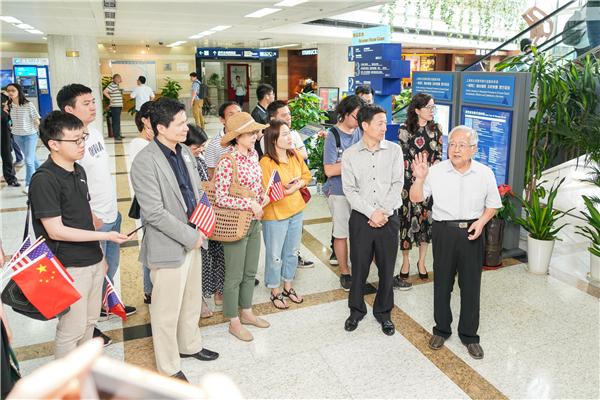
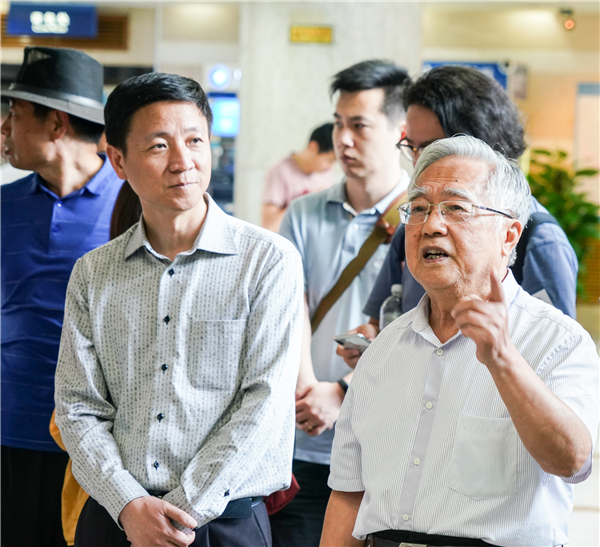
(Director of the Shanghai Library Chen Chao, and former Party Secretary of the Shanghai Library Wang Heming)
Promoting cultural interaction through books
As holders of historical, cultural and scientific knowledge, as well as entertainment, books can attract readers from all over the world. So the cultural interaction between Shanghai and San Francisco started from the cooperation of their libraries.
In June 1979, the Mayor of San Francisco Dianne Feinstein visited Shanghai for the first time with a trade delegation, which was greeted by Zhao Xingzhi, Vice Mayor of Shanghai and the Foreign Affairs Director. Dianne said San Francisco had a special bond between Chinese and US people. She also believed that the friendly interaction between the two countries would be promising because they had a lot in common.
Dianne felt honored visiting such a big country that had made significant contributions for all humanity. She said the Pacific Ocean could not prevent Sino-US friendship. She would like to learn more about Shanghai’s economy and culture, devoting herself to increasing the mutual understanding.
At the end of her visit to Shanghai, she sent a key to the Shanghai people and a steel cable from the Golden Gate Bridge to Zhao, which represented the close cooperation and the intimate relationship between China and the U.S.
The next year Zhao paid San Francisco a visit with a goodwill mission. On January 28, 1980, Zhao and Dianne signed the Agreement on Friendship City Relations between Shanghai and San Francisco. Since then, San Francisco has been a sister city to Shanghai.

(Zhao Xingzhi, vice Mayor of Shanghai and Foreign Affairs Director shakes hands with Dianne Feinstein, Mayor of San Francisco. Photo provided by SPAFFC)
In November 1986, invited by Jiang Zemin, Mayor of Shanghai at that time, Dianne Feinstein visited Shanghai for the fourth time. She attended the graduation ceremony of the first senior management class of the Shanghai International Business School, which was operated jointly by China and the US, as well as the opening ceremony of the San Francisco-Shanghai Friendship Library. As a permanent project, Shanghai and San Francisco exchange 5,000 books each year.
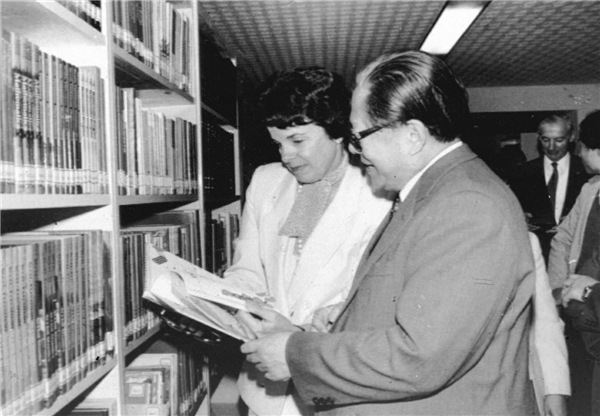
(Mayor of San Francisco Dianne Feinstein and Mayor of Shanghai Jiang Zemin. Photo provided by SPAFFC)
Inspired by the cultural interaction between Shanghai and San Francisco, since 2002 the Shanghai Library has promoted the “Window of Shanghai” project, a cultural exchange project based on book donations to overseas readers, aiming to introduce Chinese culture to foreigners.
The subjects of the donated books range from Chinese art, economy, people, history, philosophy, literature, culture and folk traditions, natural and artificial sights, cookery, traditional Chinese medicine and architecture. Most of them are published in either Chinese or English or both, with editions in French, German, Russian, Japanese, Korean and other languages to meet the demand of the foreign readers. As of October 2018, the library had established relations with 168 institutions in 72 countries and regions across six continents, donating nearly 120,000 paper books.
China and US establish strategic partnership
In the Sino-US Joint Communiqué (Shanghai Communiqué), the US recognized the Government of the People’s Republic of China as the sole legal Government of China. It also claimed that within that context, the people of the US would maintain cultural, commercial, and other unofficial relations with the people of Taiwan. In order to reduce tensions between Beijing and Washington, Bill Clinton, US president at that time, paid a visit to China in 1998. Thus a strategic partnership was established, signifying the resumption of normalized relations between the two countries.
“It was here that Clinton reiterated three principles for Taiwan,” said Wang. He was still filled with excitement, while recalling Clinton’s visit to Shanghai 21 years ago.
On June 30, 1998, accompanied by Xu Kuangdi, then city mayor of Shanghai, Bill Clinton and his wife Hilary visited the Shanghai Library. Clinton asked about the number of readers per day and the number of library cards. Then the presidential couple held a symposium titled “Constructing a 21st-Century China” at the hall, together with people from all walks of life such as law, education, religion, literature and art. They also had a further discussion on the issue of Taiwan, Sino-US scientific and technological cooperation, and educational exchanges.
Bill Clinton reiterated US rejection of the possible independence of Taiwan, the theory of “One China, One Taiwan” and Taiwan’s membership of any international and regional organizations that can only be joined by sovereign states. The next day, Hilary made a personal speech at the auditorium of the library.
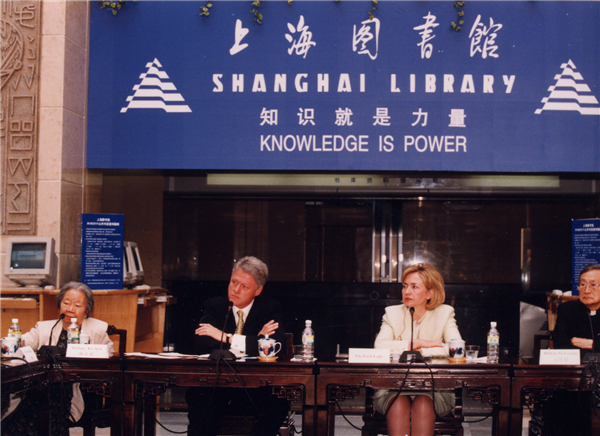
(Bill Clinton and his wife Hilary take part in a symposium)
“I did not know that President Clinton was part of such an important gathering here,” said Philip Jarrel, a cross-border artist, after listening to the witnesses’ narrative,“It made me search for the full dialogue of the meeting which I have still not found.” He regarded the open discussions as the best path to understanding between people and nations and the Shanghai Library as a fitting place to make that point. According to him, life is so complicated for people living in cultural structures, and much is not known to those outside looking in.“The language barrier alone can be a source of great misunderstanding. Therefore, patience and open sharing is our greatest hope for acceptance and peaceful coexistence,” he added.
The fourth floor of the library is the Foreign Publication Reading Area, where the San Francisco-Shanghai Friendship Library, the United Nations Repository Library and the Foreign Newspapers and Periodicals Reading Area reside.“In the former CD Reading Room, the Clintons posed for a photo with our readers,” said Miao.

(Bill Clinton and his wife Hilary pose for a photo with readers at the Shanghai Library’s CD Reading Room. Photo provided by the Shanghai Library)

(Bill Clinton shakes hands with a reader at the Shanghai Library. Photo provided by the Shanghai Library)
In the 1990s, as China’s computer industry was just beginning, computers were rare objects for common citizens. However, the Shanghai Library set up an e-reading room for people to access the Internet, which left a deep impression on the Clinton couple. The former US president also suggested resource sharing between the Shanghai Library, New York Public Library and the Library of Congress.
To keep pace with current technology, the library, containing the Institute of Science and Technology Information of Shanghai, keeps upgrading its service system in both physical and virtual spaces, so as to build itself into an open world-class comprehensive library. A 3D printer was introduced to one of the library’s specialized areas.
21 years ago, Bill Clinton’s visit to the library bridged the cultural exchange between China and the US. Before departure, he said it was a good library. Now, 21 years later, while cherishing the memory, people also experienced the evolution of the library into a true 21st-century world leader, mirroring the development of the city it is in.
Story by Tan Huiming, Shi Yue and Wu Qiong
Translated by Shi Yue and Wu Qiong
